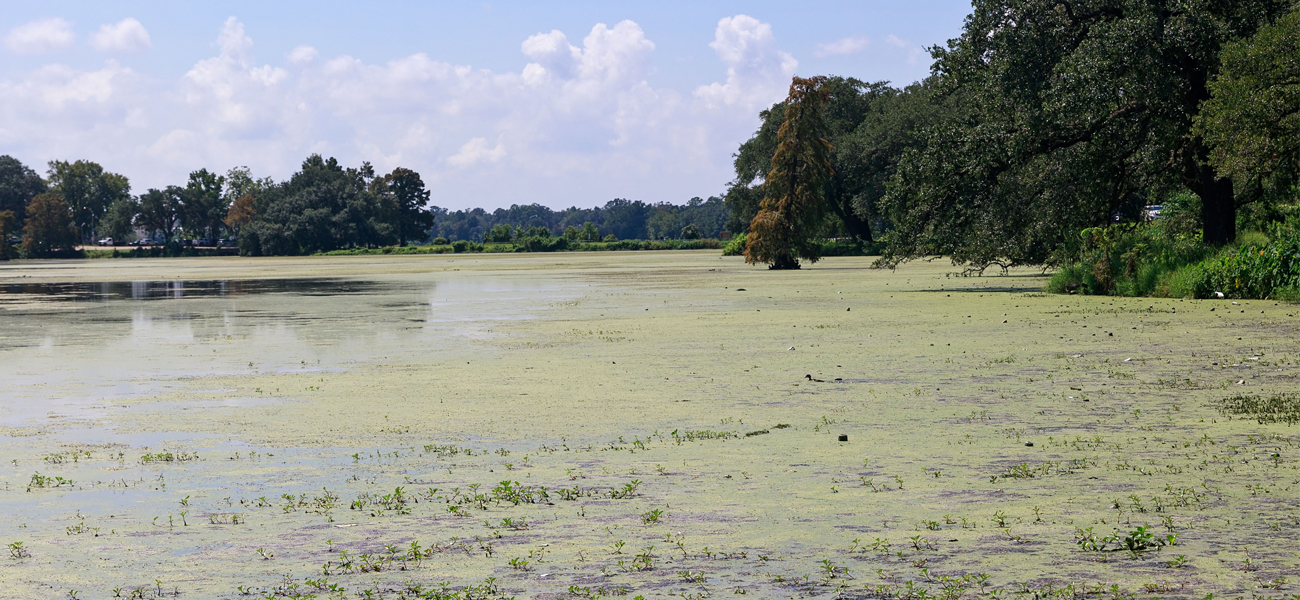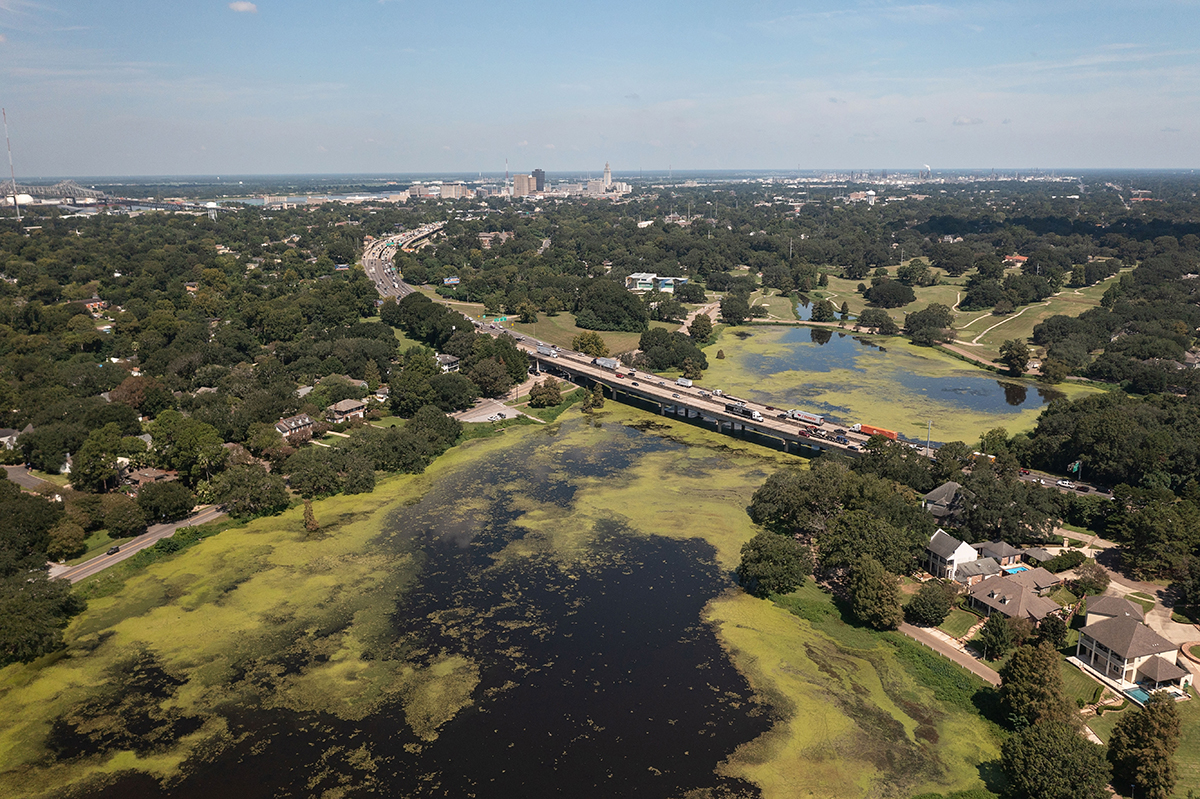
With the University Lakes Project finally underway, here’s when residents will see improvement
It might be Baton Rouge’s most popular recreational feature, but lately, the look—and smell—of the University Lakes suggests its long-awaited improvements are coming not a minute too soon.
By late summer, algae blooms had spread over most of the surface of City Park Lake, the six-lake system’s second largest body of water. In University Lake, invasive water hyacinths had choked the Dalrymple Drive shoreline, extending for several yards into the lake itself.
The overabundance of vegetation around the two main lakes was worse than ever. And in the baking summer sun, big sections of plant life were rotting, releasing foul odors even as runners and walkers continued to use the area for exercise.
|
|
Since the lakes system was converted from a cypress swamp to a series of lakes in the 1930s, its shallow depths have invited too much vegetation to grow. The lakes have also been unable to properly filter nutrient runoff that drains into the water bodies from stormwater. It’s a problem that’s visibly worsened with each passing year.

At the same time, however, this summer also finally provided visual evidence that the lakes’ highly anticipated restoration project had kicked off.
In August, a four-week dredging test run, known as the Advanced Work Project, concluded in a small portion of University Lake near East Lakeshore Drive and Stanford Avenue.
Its purpose was to dredge one small area before major dredging begins in earnest, and to create a small island with the dredge materials to examine their usefulness in building up shorelines, future additional islands and pedestrian pathways.
The exploratory work is helping construction teams learn more about the lakes’ conditions before the project kicks off.
The next step, says University Lakes Project lead and CSRS Principal Mark Goodson, is to wait for final permitting from the Army Corps of Engineers, which is expected to come by the end of the year. Once that’s in place, the first phase of the actual work in restoring and improving the lakes can begin.
Phase I includes dredging and deepening five of the six bodies of water in the system to about 10 feet. Those include City Park Lake, Lake Crest, Lake Erie, Campus Lake and College Lake. (Dredging of University Lake will occur in Phase II.)
A previous hurdle—the $35 million required for Phase I improvements—has also now been cleared, said Gov. John Bel Edwards, Mayor Sharon Weston Broome and other officials in a late April announcement, which will allow the project to move forward.
For decades, the idea to improve the water quality and recreational potential of the University Lakes has been discussed by community leaders.
But in 2016, the idea began garnering serious attention, when the Baton Rouge Area Foundation funded a high-caliber master plan created by Boston-based firm Sasaki.
The plan triggered new momentum for an overhaul. A complex new entity representing the lakes’ many stakeholders, including LSU and BREC, was formed to oversee the project. Called University Lakes LLC, the organization was established by the LSU Real Estate and Facilities Foundation, an affiliate of the LSU Foundation. LSU owns University Lake and three of the smaller lakes near it, while BREC owns City Park Lake as well as Lake Erie. The day-to-day operations of University Lakes LLC is managed by local firm CSRS.
Goodson says the forthcoming dredging in Phase I will address City Park Lake’s current algae bloom and overabundance of vegetation.
“Part of the reason the algae is flourishing in City Park Lake is the water is shallow and warm and has little oxygen,” Goodson says. “It’s full of organic material and nutrients that algae like, and a big part of what we’re doing with the dredging is to eliminate those conditions.”
Goodson continues, “We’re deepening lakes so sunlight won’t be able to reach the bottom and vegetation won’t be able to grow so easily, and the water column will be able to move and keep the water circulating.”
While dredging is seen as the lake’s lynchpin project, there’s more to Phase I than just deepening the lake bottom. This part of the project, which should be completed by December 2023, also calls for two major pathway improvements. One is a new pedestrian boardwalk that will cross University Lake and connect East Lakeshore Drive to South Lakeshore Drive (the area known as the Peninsula).
A second Phase I project removes barriers between City Park Lake and University Lake at May Street so that water will flow between them.
May Street will be realigned to include a new bridge crossing over the newly linked lakes, and the current May Street greenspace and parking area will be reshaped to include pedestrian pathways that extend to East Lakeshore Drive, an intersection now known for its dangerous pedestrian conditions.

In addition, Campus Lake, which is mostly silted in, will also be partially filled to create greenspace and pathways connecting LSU’s Miller Dorm to parking lots assigned to its residents. Design firm Sasaki will complete the Phase I design by the end of this month, Goodson says.
But while the community has been eagerly awaiting these improvements, some homeowners around the lakes are concerned, says attorney George Bayhi, who, along with Carolyn Moore, are nonvoting community representatives on the Lakes’ project advisory board.
At a public meeting in August, residents voiced skepticism about the viability of the landscaping and designs proposed for the project. More than 100 participants attended the meeting.
“I get regular calls from people expressing dissatisfaction with some of the proposals beyond dredging the lake,” Bayhi says. “Our neighbors are very concerned that their concerns aren’t really being addressed.”
Specifically, residents of the Stanford Point condominiums, which overlooks the section of University Lake where the boardwalk will be built, don’t like the idea of a public boardwalk being constructed near the backs of their homes, Bayhi says.
He also says that homeowners are concerned about who will ultimately oversee the University Lakes’ maintenance, since more recreational features will no doubt draw additional users who bring more cars and more litter.
“There’s never been any plan on who’s going to maintain these improvements,” Bayhi says.
At least not yet. BREC Superintendent Corey Wilson, a voting member of the advisory board, says the project partners are determining the costs of annual maintenance and who will oversee it.
Currently, BREC and the City Parish are the primary providers of maintenance, which includes grass cutting and litter removal, Wilson says. Once the project is finished, it’s likely that a newly formed organization will provide maintenance.
“So the idea is that there will be one entity that takes care of all six lakes,” Wilson says. “Certainly, by the time we’re finished and probably much sooner than that, we’ll have a concrete plan of what that organization looks like.”
Officials aren’t sure exactly when Phase I will begin—but Goodson says they remain confident that the work will conclude by end of 2023.
What’s the latest timeline?
Phase I – to be concluded by December 2023
• Dredging (cleaning, clearing and deepening) of five of six of the lakes
• Pathway improvements, including a new pedestrian boardwalk crossing University Lake and connecting East Lakeshore Drive to South Lakeshore Drive
• Removing barriers and creating flow between City Park Lake and University Lake; realigning May Street with a bridge spanning both lakes
Phase II – TBD
• Dredging University Lake
• Pending full funding of an estimated total $31 million. It is anticipated that
$6 million will first come from state capital outlay (priority one) funds followed by another $20 million (priority five), in combination with $5 million committed from LSU Athletics.
• Future phases could include recreational amenities like improved greenspace, pedestrian pathways, boardwalks and lighting improvements, but will likely require additional funding.
This article was originally published in the October 2022 issue of 225 magazine.
|
|
|
